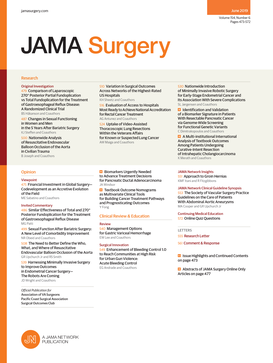Artificial Intelligence-Powered Spatial Analysis of Immune Phenotypes in Resected Pancreatic Cancer.
IF 14.9
1区 医学
Q1 SURGERY
引用次数: 0
Abstract
Importance Although tumor-infiltrating lymphocytes (TILs) have been implicated as prognostic biomarkers across various malignancies, the clinical application remains challenging. This study evaluated the applicability of artificial intelligence (AI)-powered spatial mapping of TIL density for prognostic assessment in resected pancreatic ductal adenocarcinoma (PDAC). Objective To evaluate the prognostic significance of AI-powered spatial TIL analysis in resected PDAC and its clinical applicability. Design, Setting, and Participants This cohort study included patients with PDAC who underwent up-front R0 resection at a tertiary referral center between January 2017 and December 2020. Whole-slide images of retrospectively enrolled patients with PDAC and up-front R0 resection were analyzed. An AI-powered whole-slide image analyzer was used for spatial TIL quantification, segmentation of tumor and stroma, and immune phenotype classification as immune-inflamed phenotype, immune-excluded phenotype, or immune-desert phenotype. Study data were analyzed from January 2017 to August 2023. Exposure Use of AI-powered spatial analysis of the tumor microenvironment in resected PDACs. Main Outcomes and Measures Tumor microenvironment-related risk factors and their associations with overall survival (OS) and recurrence-free survival (RFS) outcomes were identified. Results Among 304 patients, the mean (SD) age was 66.8 (9.4) years with 171 male patients (56.3%), and preoperative clinical stages I and II were represented by 54.3% patients (165 of 304) and 45.7% patients (139 of 304), respectively. The TILs in the tumor microenvironment were predominantly concentrated in the stroma, and the median intratumoral TIL and stromal TIL densities were 100.64/mm2 (IQR, 53.25-121.39/mm2) and 734.88/mm2 (IQR, 443.10-911.16/mm2), respectively. Overall, 9.9% of tumors (30 of 304) were immune inflamed, 85.2% (259 of 304) were immune excluded, and 4.9% (15 of 304) were immune desert. The immune-inflamed phenotype was associated with the most prolonged OS (median not reached; P < .001) and RFS (median not reached; P = .001), followed by immune-excluded phenotype and immune-desert phenotype. High intratumoral TIL density was associated with longer OS (median, 52.47 months; 95% CI, 41.98-62.96; P = .004) and RFS (median, 21.67 months; 95% CI, 14.43-28.91; P = .02). A combined analysis of the pathologic stage with immune phenotype predicted better survival of stage II PDAC stratified as immune-inflamed phenotype than stage I PDAC stratified as non-immune-inflamed phenotype. Conclusions and Relevance Results of this cohort study suggest that the use of AI has markedly condensed the labor-intensive process of TIL assessment, potentially rendering the process more feasible and practical in clinical application. Importantly, the IP may be one of the most important prognostic biomarkers in resected PDACs.人工智能驱动的胰腺癌切除术免疫表型空间分析。
尽管肿瘤浸润淋巴细胞(til)已被认为是各种恶性肿瘤的预后生物标志物,但其临床应用仍然具有挑战性。本研究评估了人工智能(AI)驱动的TIL密度空间映射在切除胰腺导管腺癌(PDAC)预后评估中的适用性。目的评价人工智能驱动的空间TIL分析在PDAC切除术中的预后意义及其临床应用价值。设计、环境和参与者本队列研究纳入了2017年1月至2020年12月在三级转诊中心接受R0切除术的PDAC患者。回顾性分析PDAC和R0切除术患者的全片图像。使用人工智能驱动的全片图像分析仪进行空间TIL定量,肿瘤和间质分割,并将免疫表型分类为免疫炎症表型,免疫排除表型或免疫荒漠表型。研究数据分析时间为2017年1月至2023年8月。人工智能对切除的pdac肿瘤微环境的空间分析。确定肿瘤微环境相关危险因素及其与总生存期(OS)和无复发生存期(RFS)结果的关系。结果304例患者中,平均(SD)年龄为66.8(9.4)岁,男性171例(56.3%),术前临床分期I期和II期分别占54.3%(165 / 304)和45.7%(139 / 304)。肿瘤微环境中的TIL主要集中在间质,瘤内TIL和间质TIL的中位密度分别为100.64/mm2 (IQR, 53.25-121.39/mm2)和734.88/mm2 (IQR, 443.10-911.16/mm2)。总体而言,9.9%的肿瘤(304例中30例)为免疫炎症,85.2%(304例中259例)为免疫排除,4.9%(304例中15例)为免疫荒漠。免疫炎症表型与最长的OS相关(中位数未达到;P < 0.001)和RFS(中位数未达到;P = .001),其次是免疫排除表型和免疫荒漠表型。高瘤内TIL密度与较长的OS相关(中位,52.47个月;95% ci, 41.98-62.96;P = 0.004)和RFS(中位数,21.67个月;95% ci, 14.43-28.91;p = .02)。病理分期与免疫表型的联合分析预测,II期PDAC分层为免疫炎症表型比I期PDAC分层为非免疫炎症表型的生存率更高。本队列研究的结果表明,人工智能的使用显著缩短了劳动密集型的TIL评估过程,可能使该过程在临床应用中更加可行和实用。重要的是,IP可能是切除的pdac最重要的预后生物标志物之一。
本文章由计算机程序翻译,如有差异,请以英文原文为准。
求助全文
约1分钟内获得全文
求助全文
来源期刊

JAMA surgery
SURGERY-
CiteScore
20.80
自引率
3.60%
发文量
400
期刊介绍:
JAMA Surgery, an international peer-reviewed journal established in 1920, is the official publication of the Association of VA Surgeons, the Pacific Coast Surgical Association, and the Surgical Outcomes Club.It is a proud member of the JAMA Network, a consortium of peer-reviewed general medical and specialty publications.
 求助内容:
求助内容: 应助结果提醒方式:
应助结果提醒方式:


